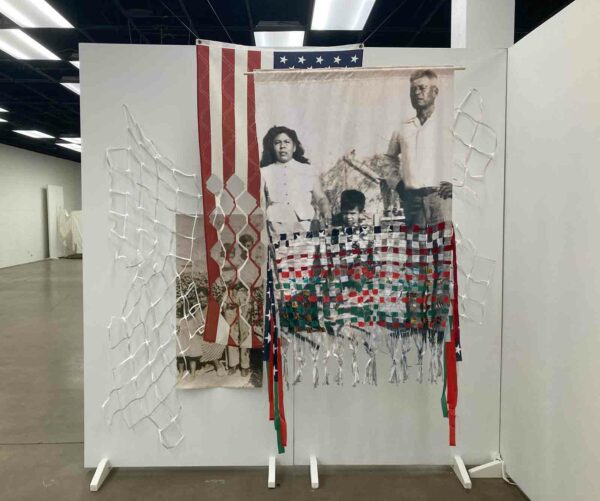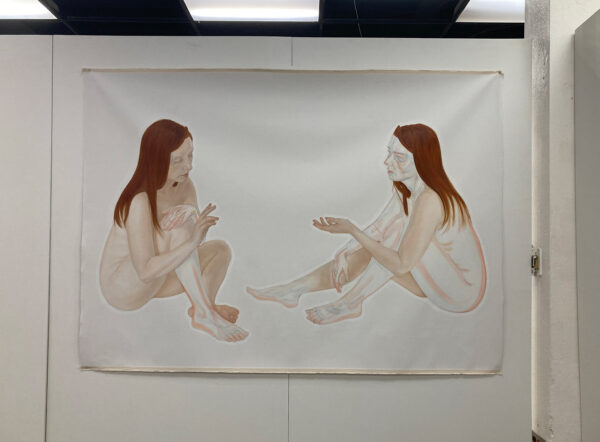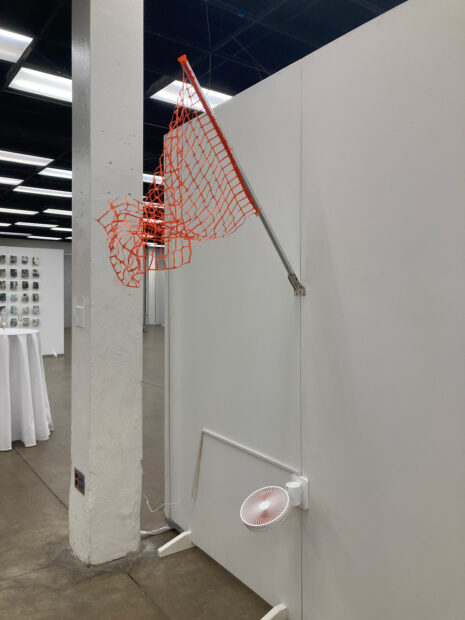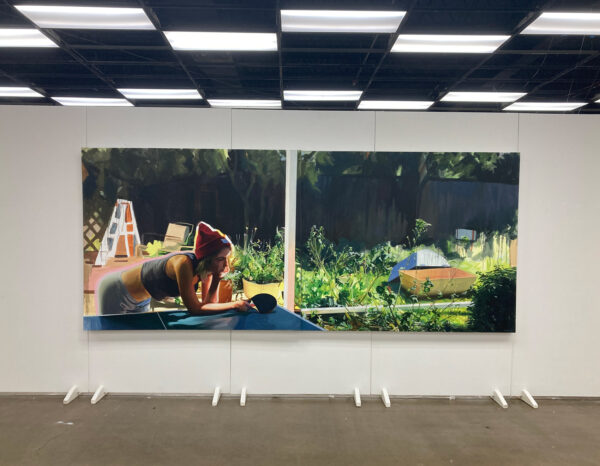At the Texas Vignette art fair, Emily Edwards, who is the Associate Curator at Dallas Contemporary and selected the artists for this year’s edition, said in her curatorial statement, “I looked for consistency throughout [an artists’] work, a command of their chosen medium, and a strong point of view.” When viewed through this lens, the exhibition delivered on all fronts.
Consistency in an artist’s oeuvre is a relevant factor for curating an art fair. This annual program, which in its first years was planned as a “satellite art fair” to the larger, more storied Dallas Art Fair in April, represents an effort to canonize the output of women in the region who have dedicated their careers to making art. Texas Vignette has since changed its location, from the Texas Women’s Museum on the State Fair grounds to Dallas Market Hall on the west side of town. It has also shifted programming to the fall, separating its calendar entirely from the frenzy of the spring fair season.

Tina B. Medina, “sacrificios por una patria/ sacrifices for a homeland,” 2023, photo on canvas and fabric, flags, paper, thread, 96 x 96 x 24 inches
Which of the artists in this year’s fair showed a consistent body of work? Tina B. Medina’s sacrificios por una patria/sacrifices for a homeland makes use of the American flag, incised with a chain link pattern, and family photographs interlaced with textiles, suggesting a blending of American and Mexican nationalities. Though these are common themes Medina addresses, the fair presentation was larger and less bound to a frame or substrate than in previous exhibitions, like her 2022 retrospective at the Latino Cultural Center.

Victoria Brill, “considering all that we have become,” 2022, oil and graphite on
canvas, 60 × 84 inches
Victoria Brill’s considering all that we have become is a large nude self-portrait in oil and graphite, rendered in the artist’s scintillating realism which shows the artist in fine detail, leaving sections of her face and body pallid in contrast to the vibrant color of her hair and skin. Candace Hicks’ Notes for String Theory are works I’ve seen from the artist before, usually in the exact same format shown here: composition notebook-shaped canvases embroidered with blue rule lines that warp, and red lines that navigate through the wormholes. In these works, it is apparent that Texas Vignette intends to present career achievements from women artists to the public, and make them available for sale.
Sarah DePetris’s works stunned, and seemed to project themselves outward into the rest of the space. Ghost Rainbow #7 is a smudgy painting that extended from the ceiling to the floor, and was an example of Edwards’ good sense not to crowd Dallas Market Hall with too much stuff. Daydream Scenes, by comparison, is a graphite drawing of dancing scribbles on a wide sheet of paper bordered with a delicious deckle. Almost #13 splits the difference between these two works, deconstructing various formal elements of painting and drawing, spreading them across space and time.

Julie Libersat, “S.O.S.,” 2022, laser cut satin, aluminum flagpole, bracket, fan, 72 x 24 x 24 inches
Julie Libersat’s S.O.S. emulates orange plastic barrier fencing by way of laser-cut satin. The fabric hangs from a pole bracketed to the wall and is activated by a fan, creating an obvious flag despite the unconventional material. Libersat said of the work, “I’m interested in feminizing these masculine signs of infrastructure, but also invoking a clarion call for crisis. I’m interested in using transportation as a subject matter and metaphor for our directionality in life and orientation towards capitalism.” Libersat is known to work in a variety of materials and to use new media fabrication techniques and exhibition strategies, often as a means of pushing her own boundaries.
Natalia Padilla showed a work that has lived in her apartment for two years. Relish is an original photograph that’s been pasted to raw canvas and colored over with oil pastels and Mod Podge. She told me she felt excited to bring it to the fair because she didn’t design the work, in the way she does when producing graphic design for her clients. Straddling the line between contemporary artist and graphic designer, Padilla created this work as a part of developing RELISH, a coloring book and promotional campaign to educate children in Dallas about eating a healthy, diverse diet. Though that project has all the aesthetic trappings of a meticulously coordinated product, the work hanging here is a testament to the artist’s true, more expressive creative roots.
As I passed Fort Worth painter Ariel Davis near her work, We’re Done Playing, I asked her what motivated her to submit to Vignette. She had a quick answer: size matters. “This is my first time [in the fair], and one of the reasons I applied with the two works that I have in this show is because they’re larger pieces, and Vignette did not have a size limitation for entries,” said Davis. The aforementioned painting is 144 inches on its longest side, which is also the case for Aubree Dale’s triptych, Where We Always Meet.
Walking the floor of Dallas Market Hall, one would not assume any size or format of show could fit in the confines of this space. It is a generally agreeable venue for showing art, sure. The movable walls and high ceilings allow for ample surface area and an airy walking experience. The only works that suffer, as a result, are the projected video pieces. The lighting in the space, while crisp, does not seem to be modular. It’s either all on or all off, meaning the projectors cannot compete with the overhead lighting. Curators tasked with placing work in large group shows such as this will sometimes install videos outside during evening hours, although this wouldn’t have helped much, as Texas Vignette had a mostly daytime schedule. The video pieces shown on monitors come through, however, which begs the question of whether some limitations on works accepted should be made. The organizers might consider building out a small black box viewing room, as can be seen at Ro2 Art’s Bataan Street location, although I suspect this would only create more logistical and cost issues for a fair of this size.
This year, the art fair offered exhibiting artists the chance to sell their work online through Shopify, which is something that the COVID-19 pandemic has made standard for exhibitions of this kind. The difference with this program is that 100% of sales went directly to the artists, a pretty radical policy for an art fair. Together, these two components make Texas Vignette an exhibition that continues to see the needs of women artists and meet them with intention.
The 2023 iteration of Texas Vignette was on view November 3-4 at Dallas Market Hall.
William Sarradet is the Assistant Editor for Glasstire.





